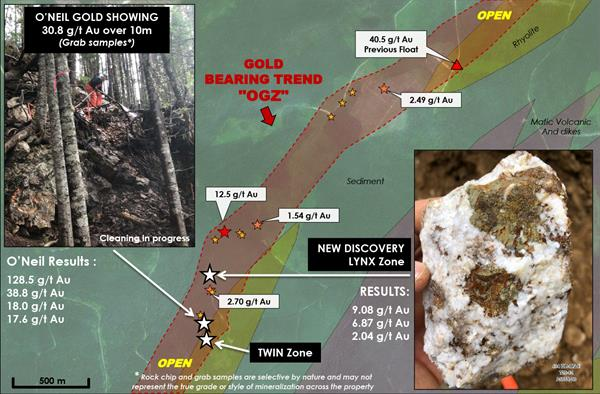Oct 23 2020
Puma Exploration Inc. has reported the finding of a new gold-bearing zone hosting up to 9.08 g/t Au on its Williams Brook property—the “Lynx Zone.”
 New gold discovery, the Lynx Showing, is located 300 m NE of O’Neil Showing. Image Credit: Puma Exploration Inc.
New gold discovery, the Lynx Showing, is located 300 m NE of O’Neil Showing. Image Credit: Puma Exploration Inc.
Located 300 m to the northeast of the O’Neil Showing, the gold discovery was achieved as part of the first phase of the current trenching program to confirm the source of the gold-bearing boulder fields reported earlier.
Highlights
- New gold discovery from ongoing trenching work with chosen grab samples grading 9.08 g/t Au, 6.87 g/t Au, and 2.04 g/t Au from bedrock*.
- The Lynx Zone is situated 300 m to the northeast of the high-grade gold O’Neil Showing.
- The finding of the Lynx Zone confirms the efficiency of the boulder, soils, and till anomalies as gold pathfinders at Williams Brook.
- To date, just 25% of the Williams Brook is covered by soil surveys, which reveal several gold soil anomalies and highly anomalous untested till samples.
- The aim of the current trenching program at Williams Brook is to confirm the maximum geochemical targets, the extension of the known gold showings, and to spot the ideal geological units, structures, and contacts.
*Selected rock grab samples are selective by nature and may not represent the true grade or style of mineralization across the property.
New discoveries are fundamental to value creation, and the latest results from the current trenching program confirms the potential for further high-value discoveries on the entire Williams Brook property as it shows numerous gold soil anomalies and extremely anomalous till samples untested, and still holds an untapped wealth of geological endowment.
Marcel Robillard, President and CEO, Puma Exploration Inc.
With the results achieved at the Lynx Showing grading 9.08, 6.87, and 2.04 g/t Au from bedrock gathered from the bottom of the trench, additional stripping and trenching will be performed as part of the current program.
In total, 280 rock samples including a combination of boulders and outcrops were gathered from the property over the course of the ongoing second phase of exploration. A majority of them are samples gathered from the ongoing trenching program. Results are awaited and will be reported once they are available.
O’Neil Gold Zone (OGZ)
As part of the first phase of the 2020 summer exploration program, the gold O’Neil Showing was discovered and found to have a considerable and pervasive gold trend across 2.0 km along the O’Neil Gold Zone (OGZ). The O’Neil Showing includes modified and brecciated rhyolite infused with quartz stockworks and quartz veins. The modified and brecciated rhyolite is open in all directions.
The highest gold sample, grading 128.0 g/t Au, belongs to the main quartz vein (which spans from 30 to 50 cm) followed and sampled, thus far, over 10 m in length. The average gold grade samples of the vein of 30.86 g/t Au over 10 m (128.0, 35.2, 18, 14.5, 10.25, 8.33, and 1.74 g/t Au) were evaluated from grab and chip samples gathered continuously every 1.5 m on the main vein.
Once the main vein was cleaned by hand and shovel, surrounding quartz veinlets and stockworks within the rhyolite were discovered, sampled, and respectively reported high-grade gold of 16.90, 8.24, 6.14, 3.57, 2.2, and 1.14 g/t Au.
Triple Fault Gold Project
The Triple Fault Gold Project hosts three properties named Williams Brook, Portage Lake, and Jonpol Gold, which together cover over 41,500 ha of propitious gold exploration land package. The project is situated around 60 km west of Bathurst, where the paved road cross-cuts the property.
At present, the focus of Puma’s field work is on the Williams Brook property, which is its first priority. The Williams Brook property encompasses selected drill results of 11.2 g/t over 2.8 m, 2.1 g/t Au over 9.0 m, and 1.0 g/t over 23 m; gold occurrences that grade up to 109.0 g/t Au, 50.8 g/t Au, 38.9 g/t Au in bedrock; several gold soil anomalies; and highly anomalous till samples including up to 508 gold grains that exist across an area of about 12 x 3 km.
The area mapped as being part of The Dunnage Zone that hosts major gold deposits and gold occurrences in siluro-devonian rocks has seen very limited drilling and exploration and is regarded as an emerging gold exploration and development district.